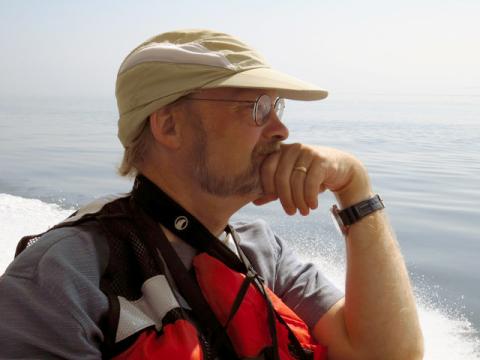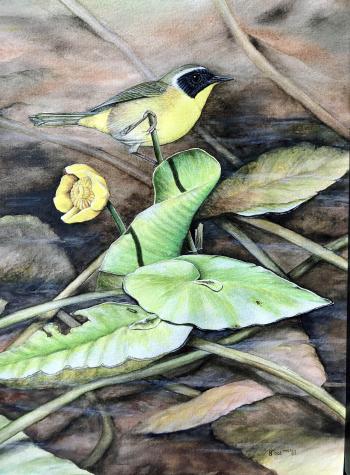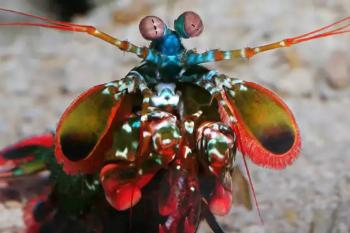
Rich's Tree of Life is here.
Mooi’s interest in natural history started at a young age. His parents came to the U.S. from Holland after the war to start a new life. Every summer Rich and his family would go on epic camping adventures across Canada. He started drawing to record whatever he saw. Capturing nature served as the beginning of Rich’s life as an artist.
As a child, Rich read about the ocean in the children’s edition of The Sea Around Us by Rachel Carson. Reading about the abyss and its “spookiness” sparked Rich’s imagination. Rich wanted to explore the ocean so much, he drew "blueprints" (in blue ink) of his future research vessel, modeled on Jacques Cousteau’s. From then on almost everything at school was focused on marine biology.
Evolutionary Novelty
In college, professors inspired Rich to develop a formalized love of discovery. When his teacher introduced Echinoderms, Rich was struck by how different they are from other animals. They have ”fewer body parts and organs than we do. They also don’t have a radial symmetry or water vascular system. I thought this was bizarre.” And ever since then, Rich sustains a keen interest in evolutionary novelty.
Rich studies the evolution of echinoderms. The oldest echinoderm fossils date back to the Cambrian period, about 550 million years ago. These fossils have five-part symmetry. And the common ancestors of all echinoderms have radial symmetry. Not everyone agrees with Rich’s perspective, saying there is a bilateral ancestor— it’s a bit controversial with lots of different opinions.
Rich is excited about his current research: building a Tree of Life of sea urchins to serve as a laboratory to study evolutionary novelty. The tree will be a molecular tree of living species, with fossils added to help tell the story. There are about 1200 living species and the fossil record has 10 times that amount. Sea urchins have skeletons that fossilize readily to preserve the morphology of the animal when it was alive.

As Much an Artist as a Scientist
The art Rich created as a kid while exploring the natural world is still a part of him. He shared, “If I wasn’t able to create art, I’d feel a part of me was missing.” His artistic skills were an integral part of his conducting science. “It’s very helpful to illustrate ideas.” Creating illustrations allows Rich to present findings in an unambiguous way. This also complemented his skills in observation and communications.
When looking at how sand dollars are constructed, plate patterns tell Rich an evolutionary story. Through his art, Rich can depict those plate patterns in a unique way, thus integrating his observations into his ideas on evolution. Rich has always been interested in the intersection of art and science. Early on, he was faced with the decision: art or science. He realized one should not be exclusive of the other.
Survival Depends on Research and Protection
Rich’s first love is the evolution of sand dollars, which are also echinoids like sea urchins. There are about 200 living species. Their evolution gives insight into how evolutionary change works. Because the sand dollars’ fossil record goes back at least 50 million years, these records also help us see how climate change has impacted them over time. During the Eocene (about 55 million years ago) ocean temperatures were much higher and sand dollars flourished at that time. Climate change was a much slower process spanning millions of years. It was slow enough for echinoderms to adapt and evolve in order to survive.
Now, the rate of climate change is so rapid animals can’t track it. This reflects evidence that climate change is driven by human activity and consumption. Maybe you've noticed changes in nature from when you were a kid. Rich did. He noticed that the birds are not as abundant as they were when he was a kid. Aquatic animals and many types of insects are missing.
Effects of Climate Change on the Sea Urchin
A sea urchin’s outer skeleton is called a test and is comprised of calcium carbonate. Experiments indicate that an acidifying ocean will decrease the rate that tests calcify. There is, however, one element of compensation- the warmer water also increases the urchin’s metabolism. But, for some animals both warming and acidification are a harmful double whammy. It’s a very delicate balance with rapidly moving pieces. It's essential that we invest in ocean research in order to adequately record the species out there and analyze the effects of climate change on them.
Rich has studied the biodiversity of sea urchins in the Philippines, where one sixth of the world’s sea urchin species resides. He worries about the future there. Fortunately, ecosystems rich in biodiversity may be more resilient and recover more quickly from warming events. This illustrates how it's especially important to protect special places that are high in biodiversity.
Spread the Love and Enthusiasm
When asked what advice he would give aspiring scientists, Rich replied, “follow your passion, even when it’s hard work. To become proficient, you have to be prepared to spend long days of hard work. You must be open to discovery.” Rich believes it’s important to share the work you’re passionate about with the general public. “If we’re to fight the anti-science tide, as scientists, we need to better communicate with all audiences. Spread the love and enthusiasm.”

Rich is very involved in education as evidenced in his work on the Biodiversity course developed by the California Academy of Sciences.
















